I am curious, what is the basis of your conclusions, if any? BTW, I did look in the texts, for example, https://www.amazon.ca/Current-Drivi...e/dp/1450544002/ref=sr_1_1?crid=16W7FLLOOWRGH, which I would wholeheartedly recommend you to study before making any claims. You could have noticed that I did measure the complex frequency-dependent impedance of audio drivers (that's actually what I started with). Of course, all measurements are reproducible. Of course, being a mathematician, I am not so stupid as to publish any "fake news". Really, what is your thought process that brought you to the conclusion of anything "made up"? Just ... how???
The book that you point out is at best a curiosity and is unlikely to show up on a university course syllabus, so in the usage in my original post it is not a text.
The book is on my shelf and has a few post-its on the pages.
Current Drive is unlikely to be mainstream. I have had some fun playing with it and measuring current distortion and similar.
Not so much "fake news" as Back page news.
I have measured more than a few drivers.
Thanks DT
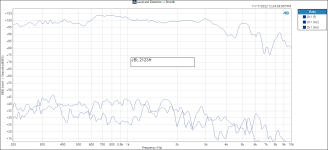
DT, Did you end up utilizing it in any of your projects, distortion reduction techniques namely lumped as "current drive"?
It was Esa Meriläinen publishing:
"Current-Driving of Loudspeakers
Eliminating Major Distortion and Interference Effects by the Physically Correct Operation Method"
It was @mikets42 publishing a video with LTI-residuals comparing voltage-drive and resistor-drive:
https://www.diyaudio.com/community/...y-matter-for-sound.409770/page-6#post-7615856
It was me "editing" it for easy comparison:
https://www.diyaudio.com/community/...y-matter-for-sound.409770/page-8#post-7616453
It was me calling out: Heinrich Barkhausen :
https://www.diyaudio.com/community/...-matter-for-sound.409770/page-12#post-7617833
Now We are here. @mikets42 has built a flawlessly working current-drive amp. He published measured graphic comparisons with his current-drive amp and the resistor-drive. (+++ 🙂 )
BTW:
Listen to this audio:
https://www.diyaudio.com/community/...-the-current-drive.417774/page-3#post-7799645
Conclusion:
Esa Meriläinen is right.
But what motivated him was not the "audible" harmonic distortion.
He heared the reduction of Barkhausen-Noise - without realizing it!
best regards
Bernd
"Current-Driving of Loudspeakers
Eliminating Major Distortion and Interference Effects by the Physically Correct Operation Method"
It was @mikets42 publishing a video with LTI-residuals comparing voltage-drive and resistor-drive:
https://www.diyaudio.com/community/...y-matter-for-sound.409770/page-6#post-7615856
It was me "editing" it for easy comparison:
https://www.diyaudio.com/community/...y-matter-for-sound.409770/page-8#post-7616453
It was me calling out: Heinrich Barkhausen :
https://www.diyaudio.com/community/...-matter-for-sound.409770/page-12#post-7617833
Now We are here. @mikets42 has built a flawlessly working current-drive amp. He published measured graphic comparisons with his current-drive amp and the resistor-drive. (+++ 🙂 )
BTW:
Listen to this audio:
https://www.diyaudio.com/community/...-the-current-drive.417774/page-3#post-7799645
Conclusion:
Esa Meriläinen is right.
But what motivated him was not the "audible" harmonic distortion.
He heared the reduction of Barkhausen-Noise - without realizing it!
best regards
Bernd
Last edited:
I suspect mr. Meriläinen is @ETM and participating the thread, hopefully he will chime in more 🙂
edit.
Ah, little bit digging message history and he is!
edit.
Ah, little bit digging message history and he is!
Hello, all pursuers of natural sound
This is to announce the publication of my new book:
Current-Driving of Loudspeakers:
Remedy to the Fundamental Fallacy of Sound Reproduction Technology
by Esa Meriläinen.
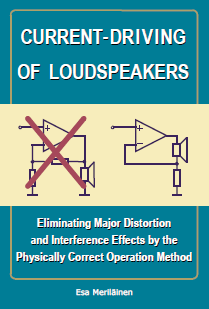
Softcover, 342 pages, available at Amazon.com.
Short introduction:
Why have the basic laws of electrodynamics been ignored in the design of all loudspeaker operations? An astounding exposure of the flaws of voltage drive and a thorough, groundbreaking guide to the only physically...
This is to announce the publication of my new book:
Current-Driving of Loudspeakers:
Remedy to the Fundamental Fallacy of Sound Reproduction Technology
by Esa Meriläinen.

Softcover, 342 pages, available at Amazon.com.
Short introduction:
Why have the basic laws of electrodynamics been ignored in the design of all loudspeaker operations? An astounding exposure of the flaws of voltage drive and a thorough, groundbreaking guide to the only physically...
- ETM
- book current drive transconductor
- Replies: 2
- Forum: Vendor's Bazaar
🙄 correction: heardHe heared the reduction of Barkhausen-Noise - without realizing it!
🙂🙂
I have just found the place on the internet where I first read about Barkhausen noise in connection with loudspeakers:
https://www.current-drive.info/6
all credits to:
Mr. Meriläinen 🙂
Last edited:
Obviously the great difference in the FR slope is then due to the (series) capacitor. BUT with such a strong filtering effect, I'm afraid it is no more voltage drive but already closer to current mode also in the voltage drive sweeps (and ordinary use). For proper comparison, the capacitor should be omitted.HPF on the current drive because the driver comes with a "safety" capacitor that is supposed to be used. Of course, you can drive it with the capacitor only in the voltage drive. In the current drive, you have to limit LF in another way.
Why decline? I can only measure things as accurately as I can, I do not even try to explain them.
You got me. 😗 (I used to have a signature, but now they are only allowed to donors.)@ETM aren't you author of the current drive book?
Quite possible, but I haven't emphasized this explanation, as I didn't have the wherewithals to quantify its significance, but maybe these things are changing now with novel analysis methods.But what motivated him was not the "audible" harmonic distortion.
He heared the reduction of Barkhausen-Noise - without realizing it!
D
Deleted member 375592
@ETM: My deepest respect and many thanks!
Yes, I should have measured both the voltage and current drive with the same HPF and without a capacitor. I figured it out only after I had done measurements but I was too lazy to redo the whole thing because it already became clear that the compression drivers' current drive does not work.
Yes, I should have measured both the voltage and current drive with the same HPF and without a capacitor. I figured it out only after I had done measurements but I was too lazy to redo the whole thing because it already became clear that the compression drivers' current drive does not work.
D
Deleted member 375592
I assure you that although I could have (unintentionally) made a few (hopefully minor) mistakes while measuring - nothing is made up. Nothing at all....
Current Drive is unlikely to be mainstream. I have had some fun playing with it and measuring current distortion and similar.
...
I'd not try to predict the future. The drivers may change to accommodate current driving - or may not. I hope the shorting ring will become history, power efficiency will approach 30%, and drivers will be united with the current driving amp, motion feedback, and FR/IR correcting DSP. For me, right now, this is an interesting research topic. I do not care about mainstream - not any more than about tasteless but nice-looking tomatoes in every shop. Yes, they are the "mainstream". So what?
I do not care about mainstream - not any more than about tasteless but nice-looking tomatoes in every shop. Yes, they are the "mainstream". So what?
This is mainstream:
“Most Americans owned an Amazon Echo in 2024”
Source:
https://www.statista.com/topics/6202/speakers-and-headphones/#topicOverview
and the biggest Echo speaker is Echo Studio (release 2019)
Whilst I don’t care about what’s mainstream, I Ike to understand what’s in the marketplace; what people are using and accepting
I’d like to see a FSAF on this device…
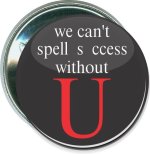
Quite possible, but I haven't emphasized this explanation, as I didn't have the wherewithals to quantify its significance, but maybe these things are changing now with novel analysis methods.
It was very rude of me to drag your name into my Barkhausen mission. I'm sorry about that. Thank you for your patient response. 🙂
Best regards
Bernd
If you want to spend time testing compression drivers I could enumerate couple expetiments that would be interesting 😀Yes, I should have measured both the voltage and current drive with the same HPF and without a capacitor. I figured it out only after I had done measurements but I was too lazy to redo the whole thing because it already became clear that the compression drivers' current drive does not work
DT, Did you end up utilizing it in any of your projects, distortion reduction techniques namely lumped as "current drive"?
Dynamic drivers are complex loads. Some say that as soon as you add any passive parts; resistors, capacitors or inductors between the amplifier and driver you have crossed over into the realm of current drive. If that is true, yes I am guilty.
Take a look at a couple of things that Purifi has to say about the addition of passive parts.
https://purifi-audio.com/blog/app-notes-2/low-distortion-filter-for-ptt6-5x04-naa-11
https://purifi-audio.com/blog/app-notes-2/side-effects-of-passive-crossover-filters-17
For grins see the attached tweeter measurement.
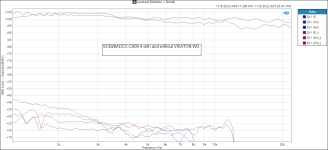
Thanks DT
No worries. And without such mentions every now and then, the book would hardly sell anything any more.It was very rude of me to drag your name into my Barkhausen mission. I'm sorry about that. Thank you for your patient response. 🙂
Very good measurements! Which loudspeaker is that?Back To The Future (1985):
More distortion measurements, see the Scanspeak P17WJ-00-08 Two-Tone FFT plot below 50Hz and 425Hz.
The side bands either side of 425Hz are the result of Intermodulation Distortion presented to the ears as Amplitude Modulation. Much more auditable and irritating than the commonly measured and reported Harmonic Distortion.
Thanks DT
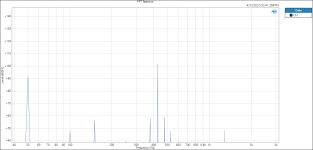
The side bands either side of 425Hz are the result of Intermodulation Distortion presented to the ears as Amplitude Modulation. Much more auditable and irritating than the commonly measured and reported Harmonic Distortion.
Thanks DT

As in, you hope them to be extinct?I hope the shorting ring will become history,
What do you feel are the disadvantages of the shorting ring?
D
Deleted member 375592
There are people on this forum and in this thread who can explain all the pros and cons much better than me. To start with, search for "The Effect of Faraday Ring (Shorting Ring) Usage on Voice Coil Impedance and Its Benefits" by Ahmet Feyz Pirimoglu
Yes member @Feyz has been around awhile.
Apart from the slightly lower sensitivity, all I see are advantages of the full copper sleeve.
Perhaps I’ve misunderstood you.
I’d like to see it as standard fare in all drivers. Top of the line drivers deserve it too.
Apart from the slightly lower sensitivity, all I see are advantages of the full copper sleeve.
Perhaps I’ve misunderstood you.
I’d like to see it as standard fare in all drivers. Top of the line drivers deserve it too.
- Home
- Loudspeakers
- Multi-Way
- Experiments with the current drive